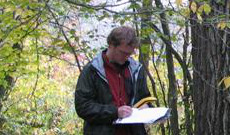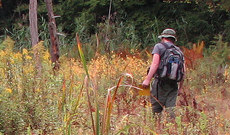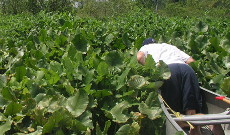 Using the Plant Community Classification
Using the Plant Community Classification
This classification is intended for use by a variety of agencies, organizations, and other conservation professionals. Its potential applications include mapping, environmental impact assessment, development planning, site selection for long-term monitoring, preserve design, and a variety of other activities related to the setting of priorities for conservation. It may also be useful in providing a common language to researchers and managers, as well as educators.
Users of the classification can identify plant communities in the field based on descriptions of plant species composition and structure of a given site. The rarity and quality rankings can be used to guide natural resources management and planning decisions. For example, state regulators may wish to require additional protection and ecological management activities in rare and/or high quality communities.
In addition to the community descriptions, two dichotomous keys for field identification of plant communities are included in this online resource to assist managers, wetland delineators, and biologists in determining the plant communities of a given area. The Terrestrial Community key follows Fike (1999). The key for the palustrine communities was developed through a program funded by the Pennsylvania Department of Environmental Protection. These keys can be printed and brought into the field for assessment activities.
Ultimately, users will need to rely on their best judgment to determine which community type description best fits a site. Thus, the descriptions and community key provided in this classification will be a useful guide in assigning community names to sites in the field.
Plant community types can be organized in several ways. Palustrine communities in the PNHP Classification can be viewed in three ways - by physiognomic category (e.g., forest, woodland, shrubland) by ecological group (e.g., basin wetland, vernal pool, peatland wetland), and by key. Terrestrial communities are organized by physiognomic system and key. Both the palustrine and terrestrial keys are organized by structural characteristics distinguishable in the field, such as percent canopy or vegetation cover and height of woody species.
In the physiognomic system of classification for both terrestrial and palustrine community types, communities are first categorized by structural vegetation layer (e.g., forest, woodland, shrubland). An additional division is made within some physiognomic categories based on dominant species (conifer, broadleaf, or combined conifer-broadleaf). This hierarchical arrangement allows the user to classify a site at a coarser level of detail if that is more appropriate, or if a specific community type cannot be determined.
Ecological groups were created for wetlands types and are made up of communities occurring together on the landscape, often dictated by physical ecological processes. Ecological Groups are similar to the Community Complexes in the first edition of the Terrestrial and Palustrine Plant Communities of Pennsylvania (Fike 1999), which listed community types commonly associated with the physiographic setting, such as River bed - bank - floodplain complex. In this edition, instead of only including representative types as Community Complexes, the Ecological Groups include all communities found within the system. Even commonly occurring, broader types that may be present in many environmental settings are included. Thus, there is a great deal of overlap in Ecological Groups. Ecological Groups were based on definitions of ecological systems adapted from the U.S. Fish and Wildlife Service wetland classification (Cowardin et al. 1979) and NatureServe Ecological Systems. Wetland types fall within one or more of the River Floodplain, Peatland Wetland, Great Lakes Region Wetland, Basin Wetland, Tidal Wetland, Coastal Plain Wetland, and Seepage Wetland categories. With updates to the terrestrial communities in 2012, PNHP is currently identifying Ecological Groups for uplands as well as wetland types.
Classification
The classification identifies characteristic species of ecological communities organized by structural vegetation layer. It describes the origin of each community description and provides a “crosswalk” to related communities described in previous Pennsylvania classifications and in the NatureServe Community Association classification.
Origin
To assist with understanding how our plant communities were developed, each community contains information on origin (from what study the type was developed) and how it relates to types in previous Pennsylvania Classifications (Fike 1999). Additional resources are provided through web-links to species information, references, and conservation/management guides.
Related Types
Each community is briefly compared to other related community types with which it might be confused. Each type is crosswalked (related) to NatureServe's International Vegetation Classification (IVC). Community types in this classification are also assigned codes developed for the Pennsylvania Bureau of Forestry and Pennsylvania Game Commission cover-typing manuals (Stone et al. 2006, PA DCNR 1999).
Conservation
Conservation concerns, threats, and management information are provided in this section. This section may change with additional research into these topics.
Range
The Pennsylvania range of each community type is given in terms of ecologically defined regions.
References
We provide research references that were used to define each plant community type and to provide conservation, management, and range information.
Gallery
A collection of photos for each plant community.
Readers can learn more about past versions of the PNHP Plant Community Classification, community ecology concepts and definitions, and references in Section 1 of the PDF version of the Terrestrial & Palustrine Plant Communities of Pennsylvania 2nd Ed. Printable versions of the Classifications are available in Section 2 and 3.
- Section 1 - Community Introduction PDF
- Section 2 - Palustrine Communities PDF
- Section 3 - Terrestrial Communities PDF
PNHP welcomes feedback from users of this classification. Please send comments or data to the following address:
Pennsylvania Natural Heritage Program
DCNR Conservation Science and Ecological Resources Division
Post Office Box 8552, Harrisburg, PA 17105-8552
This publication should be cited as:
Zimmerman, E., T. Davis, G. Podniesinski, M. Furedi, J. McPherson, S. Seymour, B. Eichelberger, N. Dewar, J. Wagner, and J. Fike (editors). 2012. Terrestrial and Palustrine Plant Communities of Pennsylvania, 2nd Edition. Pennsylvania Natural Heritage Program, Pennsylvania Department of Conservation and Natural Resources, Harrisburg, Pennsylvania.
Funding for this project was provided by the Wild Resources Conservation Program, Pennsylvania DEP, US EPA Region 3 Wetland Protection Grants, and the Pennsylvania Department of Conservation and Natural Resources.
- Plant community types can be organized in a number of ways. Initially, we have provided the
user with the ability to organize the classification two ways - by Physiognomic Category
(e.g. forest, woodland, shrubland), and by Ecological Group , which groups the communities
into ecological systems, based on shared location and ecosystem processes. An addition tool
to organize and determine the communities is the Wetland Community Key , which has a slightly
different structure, based on categorized and grouped easily in the field.
In the physiognomic classification, the community types are first divided into two major systems, palustrine (wetlands) and terrestrial (non-wetlands). These systems are then divided into physiognomic categories (e.g. forest, woodland, shrubland). For terrestrial types, a dichotomous key from Fike (1999) is provided for the this introduction to assist the user in determining which system and physiognomic category best describe a given site. One additional division is made within some physiognomic categories. In categories dominated by woody plants (forests, woodlands, and shrublands), the division is based on the dominant species (conifer, broadleaf, or combined conifer-broadleaf). This hierarchical arrangement allows the user to classify a site at a coarser level of detail if that is more appropriate, or if a specific community type cannot be determined.
Ecological Groups were created for wetlands types and are made up of communities occurring together on the landscape, often dictated by physical ecological processes. Ecological Groups are similar to the first edition's Community Complexes, which listed community types commonly associated with the physiographic setting, such as 'River bed - bank - floodplain complex.- Instead of only including representative types as Community Complexes, the Ecological Groups include all communities found within the system, even commonly occurring, broader types that may present in many environmental settings. Thus, there is a great deal of overlap in Ecological Groups. Ecological Groups were based on definitions of ecological systems adapted from the U.S. Fish and Wildlife Service wetland classification (Cowardin et al. 1979) and NatureServe's Ecological Systems. Wetland types fall within one or more of the River Floodplain, Peatland Wetland, Great Lakes Region Wetland, Basin Wetland, Tidal Wetland, Coastal Plain Wetland, and Seepage Wetland categories.
With updates to the terrestrial communities in 2012, PNHP will be identifying Ecological Groups for uplands as well as wetland types. - Characteristic species by structural vegetation layer, the origin of the concept, and 'crosswalks' and links to NatureServe Community Association and relation to previous Pennsylvania classification efforts.
- To assist with understanding of how our plant communities were developed, each community contains information on origin (from what study the type was developed) and how it relates to types in previous Pennsylvania Classifications (Fike 1999). Additional resources are provided through a web-links to species information, references, and conservation/management guides.
- Each community is briefly compared to other related community types with which it might be confused. Each type is crosswalked (related) to NatureServe's International Vegetation Classification (IVC). Community types in this classification are also assigned codes developed for the Pennsylvania Bureau of Forestry and Pennsylvania Game Commission cover-typing manuals (Stone et al. 2006, Pennsylvania Department of Conservation and Natural Resources (DCNR) 1999).
- Conservation concerns, threats, and management information is provided at this section. This section may change with additional research into these topics.
- The Pennsylvania range of each community type is given in terms of ecologically defined regions.
- We provide references to research used to define each plant community type and to provide conservation, management, and range information.
- We provide multiple photos of each community type to show the range in variability in composition and structure.









